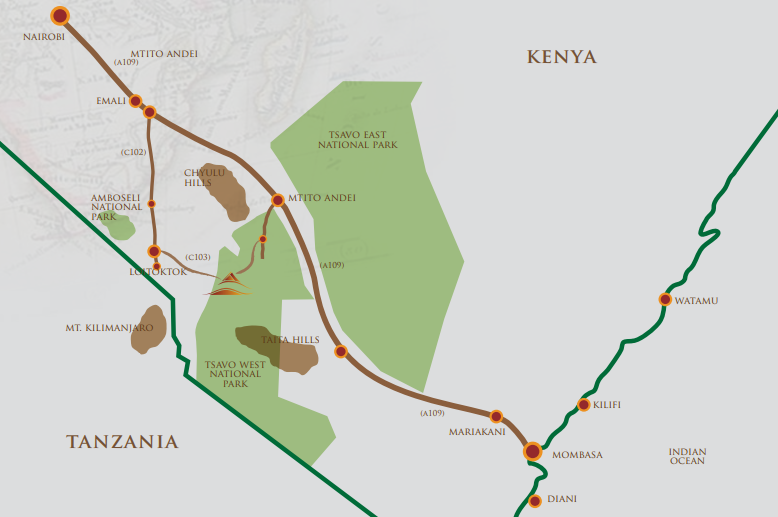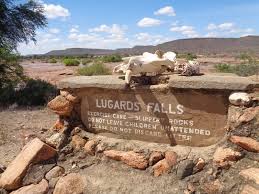Intro to Tsavo National Parks

Discover the Untamed Wilderness of Tsavo National Parks
Tsavo National Parks—comprising Tsavo East and Tsavo West—form the heart of one of Africa’s largest and most important wildlife conservation areas. Together, they anchor the expansive Tsavo Conservation Area (TCA), which spans more than 22,000 square kilometers across southeastern Kenya. This immense ecosystem is a stronghold for Kenya’s largest elephant population, a refuge for endangered black rhinos, and a living museum of geological marvels, including lava flows, volcanic hills, and crystal-clear springs.
From the red-earth plains of Tsavo East to the rugged volcanic scenery of Tsavo West, these parks offer some of the most authentic, uncrowded safari experiences in East Africa, attracting wildlife lovers, photographers, and conservationists from around the world.
This guide offers a deep dive into both parks—Tsavo East and Tsavo West—exploring their history, attractions, ecosystems, how to plan your visit, and why protecting this region is critical.
TsavoKenya.org is a resource dedicated to showcasing the beauty of Tsavo and providing helpful, action-oriented conservation measures. We are committed to raising awareness about the ecological importance of the greater Tsavo Conservation Area and inviting all visitors to become stewards of its future.
📍 Location and Access to Tsavo NPs
The Tsavo Conservation Area lies between Nairobi and Mombasa, making it easily accessible by road or rail.
- Tsavo East: Entry via Voi, Buchuma, Sala, and Manyani Gates
- Tsavo West: Entry via Mtito Andei, Chyulu, Maktau, and Ziwani Gates
Getting There:
- By Road: Approximately 5–6 hours from Nairobi or 3–4 hours from Mombasa
- By Air: Charter flights land at several airstrips inside both parks
- By Train: The SGR (Standard Gauge Railway) stops at Mtito Andei and Voi—ideal for park access
Tour operator Kambu Campers offers guided safaris with experienced driver-guides who know both parks intimately and can help you explore hidden corners beyond the main circuits.
🕰️ History of Tsavo National Parks
Tsavo East:
- Gazetted in 1948, one of Kenya’s oldest and largest parks
- Known for its Red Elephants—coated in iron-rich soil
- Site of the infamous Man-Eaters of Tsavo during the construction of the Uganda Railway
Tsavo West:
- Also established in 1948, carved out as a separate park for its distinct landscapes
- Site of key conservation efforts for black rhinos and Chyulu Hills ecosystem
- Home to the Mzima Springs, vital for water security in the region
🤔 Why Visit Both Tsavo Parks?
Though part of the same ecosystem, Tsavo East and Tsavo West offer very different safari experiences:
| Feature | Tsavo East | Tsavo West |
|---|---|---|
| Landscape | Open plains, red earth, Galana River | Hilly, volcanic, rocky, lava flows |
| Wildlife | Large herds of elephants, lions, buffalo | Rhinos, leopards, hippos, rare species |
| Terrain | Flat, wide-open views | Rugged, scenic, bushy terrain |
| Photography | Great for long-lens wildlife shots | Ideal for landscape photography |
| Accessibility | More accessible from Mombasa | Easier from Nairobi or Amboseli |
Visiting both parks gives you a complete Tsavo experience—big game, dramatic scenery, and diverse habitats all in one circuit.
🏞️ Top Attractions in Tsavo East NP
- Lugard Falls: Series of rapids and sculpted rocks along the Galana River
- Yatta Plateau: One of the world’s longest lava flows
- Aruba Dam: Watering point for elephants, giraffes, and predators
- Mudanda Rock: Natural viewpoint and popular for wildlife sightings
- Galana River Safaris: Rich birdlife and frequent big game crossings
🌋 Top Attractions in Tsavo West NP
- Mzima Springs: Crystal-clear water pools with hippos and fish
- Ngulia Rhino Sanctuary: Protected area for endangered black rhinos
- Shetani Lava Flow: Vast volcanic plain with surreal landscapes
- Chaimu Crater: Ideal for hiking and panoramic views
- Poacher’s Lookout: Hilltop lookout with 360° scenery
🌦️ Tsavo N. Parks Weather and Climate
Tsavo experiences a semi-arid to savannah climate, with two main rainy seasons:
- Long rains: March–May
- Short rains: November–early December
- Dry seasons: June–October and January–February
Average daytime temperatures range from 24°C to 33°C, with warmer nights in lowlands and cooler conditions in elevated areas like Chyulu Hills.
📆 Best Time to Visit
| Season | Best For |
|---|---|
| June–October | Dry season, great for game viewing and clear roads |
| January–February | Less crowded, excellent birding, hot weather |
| March–May | Green season, beautiful scenery, fewer visitors (but rain may affect roads) |
| November | Short rains, dramatic skies and landscapes |
💳 Entry Fees (per person, per day)
| Visitor Type | Tsavo East | Tsavo West |
|---|---|---|
| Kenyan Citizen | KES 500 | KES 500 |
| Resident | KES 1,000 | KES 1,000 |
| Non-Resident | USD 60 | USD 60 |
Additional fees apply for vehicles, camping, and special activities.
🌿 Conservation in Tsavo
The Tsavo Conservation Area plays a critical role in Kenya’s biodiversity, especially for elephants, black rhinos, and large carnivores. Conservation projects focus on:
- Anti-poaching patrols
- Elephant corridor protection (linking Amboseli and Tsavo)
- Rhino conservation at Ngulia Sanctuary
- Water security via spring and dam protection
- Human-wildlife conflict mitigation in bordering communities
Supporting responsible tourism helps sustain these programs. TsavoKenya.org promotes awareness and partnerships that empower conservation on the ground.
🏨 Where to Stay: Lodges and Camps
In Tsavo East:
- Ashnil Aruba Lodge – overviews Aruba Dam
- Satao Camp – rustic luxury with waterhole views
- Man Eaters Camp – historic location with river access
In Tsavo West:
- Kilaguni Serena Lodge – excellent wildlife viewing and Chyulu views
- Ngulia Safari Lodge – close to rhino sanctuary
- Severin Safari Camp – eco-luxury, set in open wilderness
🚙 Safaris and Tours in Tsavo
- Game drives: Morning and evening drives offer the best light and wildlife activity
- Walking safaris: Available with armed guides in select zones
- Birding tours: Over 600 species recorded across the two parks
- Cultural extensions: Visit Taita, Maasai, or Kamba communities
- Photography safaris: Best from June to October, when dust and light create dramatic images
TsavoKenya.org has partnered with dedicated conservationists, eco-tourism experts and tour operators to showcase the beauty and importance of the Tsavo ecosystem. As part of this mission, Kambu Campers is among our trusted Tsavo safaris partner offering affordable, private, and group tours with experienced safari guides deeply familiar with the Tsavo ecosystem. You can contact them directly for Tsavo camping and eco-friendly safaris.
📅 Planning Your Tsavo Safari: Tips & Essentials
- Choose your route: Nairobi to Tsavo West, then connect to Tsavo East and exit to Mombasa—or reverse
- Travel in a 4×4 during rainy season for better access to remote areas
- Book park entry online or pay at the gate (check KWS website for updates)
- Combine Tsavo with Amboseli, Chyulu Hills, or Lumo Conservancy
- Pack smart: include binoculars, sunscreen, insect repellent, reusable water bottle, and neutral safari clothing
- Support local conservation by visiting rhino sanctuaries, community-owned lodges, or donating to anti-poaching initiatives
🌍 Final Thoughts
Tsavo is a land of extremes—red dust and green oases, elephants and lava flows, lions and springs. It’s raw, untamed, and deeply rewarding for those who take the time to explore its layers.
Whether you’re planning your first safari or returning for a deeper experience, Tsavo East and West together offer one of Kenya’s most complete and wildest adventures.
And as we explore, we must also protect. By choosing responsible travel partners, supporting local conservation, and spreading awareness, we can ensure the Tsavo Conservation Area thrives for future generations.
Join Us at TsavoKenya.org
At TsavoKenya.org, we’re driven by a shared love for Kenya’s wild heart — the Tsavo Conservation Area, home to Tsavo East and Tsavo West National Parks. This platform is both a tribute to Tsavo’s vast landscapes, legendary red elephants, and timeless wilderness, and a call to action to help protect them.
Join us as we work to preserve Tsavo’s fragile ecosystems, safeguard its wildlife corridors, and ensure that future generations can experience the raw beauty of Kenya’s largest protected area. Whether you’re planning your next safari, seeking expert travel insight, or looking to get involved in conservation, TsavoKenya.org is your trusted companion for all things Tsavo.
Visit. Explore. Protect.
Galana Crocodile Camp – Riverside Safari Experience Near Tsavo East
🌍 Introduction Nestled along the banks of the Galana River, just a short distance from…
Doa Doa Safari Camp – A Riverside Safari Escape in Tsavo East
🌍 Introduction Doa Doa Safari Camp is an intimate, eco-friendly camp tucked away on the…
Guide to Landmarks & Geography of Tsavo East National Park
Tsavo East National Park, established in 1948 and covering over 13,700 km², is Kenya’s oldest…
Galdessa Camp – Timeless Safari Luxury on the Galana River
🌍 Introduction Galdessa Camp is a premier eco-luxury safari retreat nestled under doum palms and…
Impala Safari Lodge – Your Gateway to Tsavo East Adventures
🌍 Introduction Nestled at the foothills of Mwakingali Hills in Voi, Impala Safari Lodge offers…
Red Elephant Safari Lodge
🌍 Introduction Situated just 700 meters from the Voi Gate of Tsavo East National Park,…
Sentrim Tsavo Lodge
🌍 Introduction Nestled within the expansive Tsavo East National Park, Sentrim Tsavo Lodge provides guests…
Voyager Ziwani Tented Camp – Tranquility on the Ziwani River
🌍 Introduction Tucked away on the banks of the Sante River near the western boundary…
Voi Safari Lodge
🌍 Introduction Perched atop a rocky hill overlooking the vast savannah of Tsavo East National…
Kilaguni Serena Safari Lodge
🌍 Introduction Set against the backdrop of Mount Kilimanjaro and the rolling Chyulu Hills, Kilaguni…
Ashnil Aruba Lodge
🌍 Introduction Ashnil Aruba Lodge is one of the most well-established safari lodges in Tsavo…
Patterson’s Safari Camp
🌍 Introduction Nestled along the banks of the Athi River in Tsavo East National Park,…
Ndololo Safari Camp
🌍 Introduction Ndololo Safari Camp is a classic tented safari camp located deep within Tsavo…
Shoroa River Camp
Shoroa River Camp is an exclusive safari camp nestled within the Galana Wildlife Conservancy, bordering…
Ithumba Camp
🌍 Introduction Ithumba Camp is a secluded, self-catering safari property nestled in the remote northern…
Boma Simba Safari Lodge
🌍 Introduction Nestled just 1.5 kilometers from the Tsavo East National Park gate, Boma Simba…
Kipalo Hills Lodge
🌍 Introduction Kipalo Hills Lodge is a hidden gem located in Mbulia Conservancy, part of…
Hunters Lodge
🌍 Introduction Hunters Lodge is a 3.5-star hotel nestled on 25 acres of lush gardens…
Kivuli Camp
🌍 Introduction Kivuli Camp is a small, off-the-grid bush camp located in the heart of…
Sarova Taita Hills Game Lodge
🌍 Introduction Sarova Taita Hills Game Lodge is a serene and stylish safari lodge nestled…
Rhino Valley Lodge
🌍 Introduction Rhino Valley Lodge is a rustic yet comfortable safari lodge located within the…
Ngulia Safari Lodge
🌍 Introduction Ngulia Safari Lodge is a mid-range safari lodge perched dramatically on the edge…
Lake Jipe Eco Lodge
🌍 Introduction Lake Jipe Eco Lodge is a peaceful hideaway located near the shores of…
Soroi Leopard Lair
🌍 Introduction Soroi Leopard Lair is a secluded and self-catering bush camp set in the…
Soroi Cheetah Tented Camp– A Hidden Gem in the Wild Heart of LUMO Conservancy
🌍 Introduction Soroi Cheetah Tented Camp is a serene, intimate camp located deep within the…
Man Eaters Camp
🌍 Introduction Man Eaters Camp is a mid-range, family-owned safari camp that combines historical intrigue…
Soroi Lions Bluff Lodge– Safari Solitude with Stunning Vistas
Introduction to Soroi Lions Bluff Lodge Perched on a rocky bluff overlooking the sweeping plains…
Severin Safari Camp– Sustainable Luxury in the Heart of Tsavo West
🌍 Introduction to Severin Safari Camp Severin Safari Camp is a beautifully designed eco-luxury tented…
Finch Hattons Luxury Tented Camp – Tsavo’s Premier Wilderness Retreat
🌍 Introduction to Finch Hattons Safari Camp Finch Hattons Luxury Tented Camp is the epitome…
Is Malaria a Risk in Tsavo East? What You Need to Know
savo East National Park, one of Kenya’s largest and most famous safari destinations, is home…




